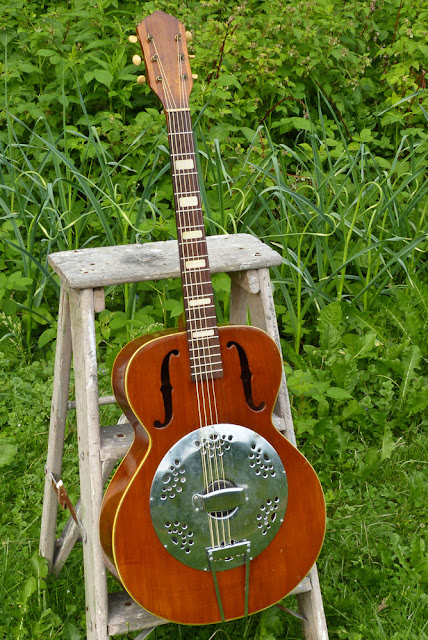1950s Kay K90 (National Cone) Resonator Guitar
Just a note: in the above soundclip a sleeve button randomly rattles once in a while on the coverplate and I didn't notice it while I was recording. Sorry! I noticed it after when I was playing this on the porch...
I worked on one of these last year and a friend now owns that guitar (which has gotten lots of gigging use). This time around I knew about the curiosities of this model ahead-of-time, so I eliminated foreseeable problems from the get-go. The result is, like the other K90 I worked on, an incredible-sounding resonator. It's warm, full, jazzy-rich, and extremely loud. Its nice tone begins with a full-size original National 9 1/2" biscuit cone under the hood and is followed-up by a 000-size laminate wood body and long scale length. The combination of these features really allows the cone to develop a warm, sweet bloom that you don't typically get from a resonator.
I worked on one of these last year and a friend now owns that guitar (which has gotten lots of gigging use). This time around I knew about the curiosities of this model ahead-of-time, so I eliminated foreseeable problems from the get-go. The result is, like the other K90 I worked on, an incredible-sounding resonator. It's warm, full, jazzy-rich, and extremely loud. Its nice tone begins with a full-size original National 9 1/2" biscuit cone under the hood and is followed-up by a 000-size laminate wood body and long scale length. The combination of these features really allows the cone to develop a warm, sweet bloom that you don't typically get from a resonator.
The body is laminate spruce over laminate mahogany. This one looks like it's had a topcoat of finish at some point in its life.
Work included: planing the fretboard and a refret right off the bat (these necks tend to warp and this one definitely had some relief to it), fixing-up of the soundwell (glued a crack in it), adding legs under the soundwell (or "soundposts" rather) to keep it stable, modification of the biscuit and saddle (so it'd play in tune), and then a full setup and cleaning, of course. The neck had been "reset" with a toggle bolt (!) sometime long ago and was still good to go. I added a big hex-bolt and washer to that job on the inside to make sure it'd stay true.
The 1 5/8" original bone nut was still useful after the neck work. This guitar has an unreinforced neck with a long scale (25 7/8"!), so I found that for standard pitch, an extra-light set of 46w-10 strings gave plenty of boom and volume, while for players who detune for open tunings, a set of 50w-11 was ideal.
A regular set of 12s would certainly kill the neck over time due to the long scale and is probably why so many of these have lightly-warped necks. It's nice to play one of these with a planed/refretted neck because you get to play it in its ideal form and with an accurate, fast setup. It feels like an Alpha dog! This one's rolling with 3/32" bass and 1/16" treble at the 12th fret -- spot on.
One benefit of the board-level and refret is that that nice chunk of Brazilian rosewood is now no longer covered in thick glossy finish (these came from the factory like that).
The coverplate is nice, but as usual, I had to go looking cor coverplate ghosts rattling their chains after I finished work...
The tail had enough clearance to stuff some foam under its lip to get rid of off-overtones.
Old Kluson Deluxe tuners adorn the headstock.
Last year I got cat-called on a forum for my supposed "crazy alteration" of the cone lip on the last one of these I worked on. I hadn't explained, initially, that the cone had already had its lip "crimped" to fit the cramped soundwell. Here you can see the cone pulled right from the well when I first opened it up: it has the same altered edge and crimped-in foot.
Also, here's a lesson I learned over time with my friend's version of this guitar: the pine soundwell gets cracks from tension-stress over time and will severely hamper the guitar's performance if left unchecked. Here you can see a repaired one and also some "soundposts" that I started fitting to the foot of the rim to rest on the back. These wells definitely need support. The glue on the under-edge of the body is not enough to keep them healthy and suspended.
In this pic the posts aren't fully fitted, yet, but they are "recycled" -- nice maple bits from old banjo dowels that'd been split or cut-down for one reason or another and hanging out in my parts-bins.


















Comments